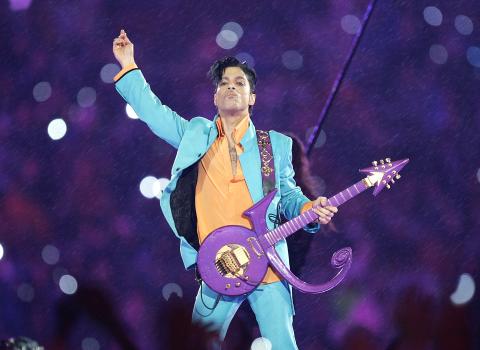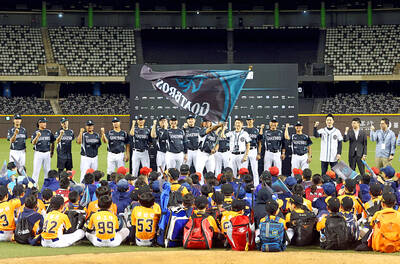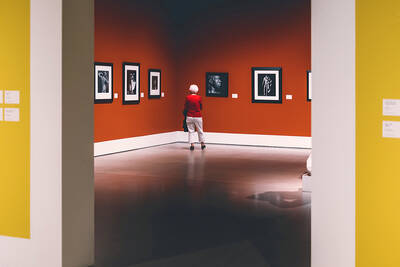“Maybe I’m just too demanding
Maybe I’m just like my father, too bold
Maybe you’re just like my mother

Photo: AP
照片:美聯社
She’s never satisfied
Why do we scream at each other?
This is what it sounds like
When doves cry”
So sang Prince, the versatile music legend who passed away on April 21, 2016, leaving behind a formidable legacy that will continue to inspire musicians for many years to come.
The haunting, minimalist ballad “When Doves Cry” was featured on one of Prince’s most acclaimed albums, “Purple Rain.” He wrote the song on the final day of the recording session, and yet it represents the most audaciously experimental side of the singer. In a single day, Prince completed both the writing and the recording of the song. He played all the instruments himself, at a time when rock bands, including Prince’s, would generally consist of a singer, one or two guitarists, a bassist and a drummer. Prince decided to remove the recorded bassline, giving the work an eccentric, stark atmosphere. Having no bass in a rock song was, and still is, very unusual for the rock — or even dance — music prevalent at that time.
In the music video, Prince’s band plays along to the track, but the lack of bassline meant there was no need for the bassist to be present. The drummer was there, but his playing was muted. During the recording session, Prince made a decision not to use drums in the song, but rather a Linn LM-1 drum machine, the first ever electronic musical instrument that uses freely programmable acoustic drum sounds, that he was using at the time.
What makes the song more unique is a long crazy guitar and synthesizer solo towards the end in the full version. The synthesizer part, which was also initially played and recorded by Prince himself, was so challenging that the band’s keyboardist was unsure if he would be able to play it live. The keyboardist later recalled that during the recording session, Prince had slowed the 24-track two-inch tape machine down to half speed, and then improvised a solo on a baroque synthesizer. After he had finished playing and recording at half-speed, he sped the tape back to its original tempo. During the live performances, however, the keyboardist still had to play the challenging synthesizer part.
Prince’s innovations — crazy solos, absent bass lines, synthesized drum sounds — were all very experimental, if not jar-dropping, at the time, and remain so even today. Prince himself said at the time of the recording: “Nobody would have the balls to do this. You just wait — they’ll be freaking.” Two months after the song was released, it topped Billboard’s Chart of Pop Singles for five consecutive weeks and remains one of his most acclaimed songs.
(Chang Ho-ming, Taipei Times)
「也許我要求得太多
也許我只是像我父親,太過魯莽
也許你只是像我母親
她永遠都不滿意
為何我們要向對方叫嚷
這樣的聲音聽起來就像
鴿子的哭泣」
Prince如此唱著。這位充滿傳奇性又多才多藝的音樂家於二○一六年四月二十一日過世,留下可觀的音樂資產,帶給後世跨越時代的永恆靈感。
縈繞聽眾心頭的「當鴿子哭泣時」(When Doves Cry) ,是一首帶有極簡抽象派風格的情歌,收錄於Prince最受盛讚的專輯「紫雨」(Purple Rain)中。這首歌曲在專輯錄音過程的最後一天才寫好,卻彰顯出這位歌手最具大膽實驗性格的一面。在一天之內,Prince就完成歌曲的創作與錄音,並一手包辦所有樂器演奏。在那個時代,一個標準的搖滾樂團──包括Prince的樂團在內──是由主唱、一到兩位吉他手、一位貝斯手,以及一名鼓手所組成。Prince自己在錄完這首歌曲後,考慮了一下,就決定將整首歌裡的貝斯聲線通通移除,讓作品呈現出極端怪異且毫無修飾的空洞氛圍。一首沒有貝斯聲線的搖滾歌曲,無論在舞曲音樂流行的當時,乃至於今天,都是相當不尋常的。
在這首歌曲的音樂錄影帶中,觀眾仍然可以看到Prince的樂團跟他一起演奏,只是貝斯手並不在場,當然是因為音樂裡完全沒有貝斯聲線的緣故,而鼓手打的鼓也是沒有聲音的。在錄音過程中,Prince決定這首歌曲不要用鼓,改用他手上持有的鼓機Linn LM-1。這台鼓聲音樂器,是當年第一台取樣於原聲鼓組,讓歌曲創作者能夠對這些取樣自由進行編製的電子樂器。
完整版歌曲在接近結尾前,有一段很長的吉他和鍵盤合成器狂熱獨奏,讓這首歌顯得更為獨一無二。這個合成樂器聲部也是Prince當初自己彈奏並錄下來的,但這段音樂實在太難,以至於Prince樂團裡的鍵盤手也沒有把握能在現場演出時如實演奏。那位鍵盤手後來回憶往事時,指出Prince在錄音過程中,把二十四軌的兩吋盤帶播放機重播速度放慢到正常的一半,然後自己跟著音樂,用巴洛克音色的鍵盤合成器開始即興演奏出這段獨奏。Prince在速度放慢一半的設定下完成演奏和錄音後,再把盤帶轉快回到原本的正常速度。不過,在現場演出時,鍵盤手仍然必須要拿出真功夫演奏,這段獨奏也確實相當具有挑戰性。
瘋狂的獨奏、被移除的貝斯聲線、合成器的鼓聲──這些特色無論是在當年,甚至時至今日,就算沒有把聽眾嚇得下巴掉下來,也堪稱相當具有實驗性。正如同Prince當年自己的預測:「沒有人會有膽量這麼做,你只要等著看就好──大家一定會嚇壞的。」這首歌曲在發行兩個月後,續連五週蟬連告示牌流行單曲榜的冠軍,直到今天都還是他最人稱道的歌曲之一。
(台北時報章厚明撰)

A: The 2025 World Masters Games will begin on May 17 and run until May 30. B: World Masters Games? A: It’s a quadrennial multi-sport event for people over 30, which will be jointly held by Taipei and New Taipei City. B: Cool, maybe we can go cheer for all the athletes from home and abroad. A: There will be an athletes’ parade in downtown Taipei prior to the opening ceremony on Saturday. Let’s go then. A: 2025雙北世界壯年運動會5月17日開幕,持續至5月30日閉幕。 B: 世壯運? A: 這是四年一度、以30歲以上青壯年為主的運動會,本屆是由台北市和新北市共同舉辦。 B: 好酷喔,我們去幫來自國內外的選手們加油吧! A: 週六在台北市區會有選手遊行,之後是開幕典禮,我們去看吧。 (By Eddy Chang, Taipei Times/台北時報張迪)

A: Where will the 35 sports of the 2025 World Masters Games be held? B: Apart from Taipei and New Taipei City, some games will take place in Yilan County, Taoyuan County, and Hsinchu County and City. A: The news says about 25,000 people, including many celebrities and sports stars, have already registered for the games. B: Even Taipei Mayor Chiang Wan-an, who is 47, registered for softball and squash. New Taipei Mayor Hou You-yi, who is 68, also registered for table tennis. A: And it will be the largest sports event ever in Taiwan’s history. How exciting. A:

Computex, Asia’s biggest electronics conference, kicked off Monday in Taipei, and as in years past drew industry chieftains from Nvidia Corp.’s Jensen Huang and Qualcomm Inc.’s Cristiano Amon to Young Liu of Foxconn, which makes the bulk of the world’s iPhones and Nvidia servers. But while last year’s event was a celebration of the post-ChatGPT AI boom, executives this time are likely grappling with the uncertainty of the Trump administration’s effort to reshape the global trade order — disrupting a decades-old model for tech manufacturing. This year’s exhibition will of course feature the hardware required to bring artificial intelligence to life.

Have you ever wondered who decides what we see in a museum or how one artwork seamlessly connects to the next? Behind every thoughtfully arranged gallery space stands a curator, a skilled professional who combines art and storytelling to craft meaningful experiences. The term “curator” originates from the Latin word cura, meaning “to care.” Curators were originally caretakers of museum collections, but over time, their role has grown to include a broad range of responsibilities that extend far beyond preservation. Today, curators manage, organize and interpret collections in cultural institutions like museums and libraries. They research, acquire and catalogue